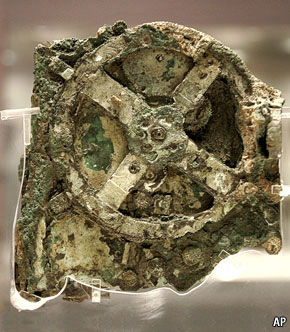Lista archport
Mensagem

[Archport] Archaeology and polynomial texture mapping
|
Archaeology and polynomial texture mapping Shining a light on the pastHow to bring out the best in ancient artefactsMar 25th 2010 | From The Economist print edition LOOK at an ancient coin under ordinary light and the chances are that its features, worn down by its passage from hand to hand, will be hard to make out. Point a spotlight at it, though, so that the face of the coin is illuminated from an acute angle, and the resulting shadows will emphasise any minor details. This is the basic principle behind a novel technique that is helping archaeologists reveal previously invisible clues hidden in the worn or damaged surfaces of any objects they uncover. From wall paintings in Herculaneum to Scandinavian stone tools to rock art in Libya, polynomial texture mapping, as the process is known, is proving an invaluable way to illuminate the past.
The Antikythera in a new light The lighting method was originally developed by Tom Malzbender, a computer scientist at HP’s laboratory in Palo Alto, California, to generate better 3-D imagery for computer games. In its most basic form, the process involves capturing between 30 and 50 digital photos of an object of interest. The pictures are taken from directly above the object in a darkened room. Though the camera is fixed, the object is lit from a different angle in every shot. The photos are then combined on a computer to create an image that can have a “virtual” light shone from various angles to reveal any hidden surface detail. The wavelength of this virtual light can also be changed using the computer, allowing colour-sensitive details of the artefact’s surface to be brought out more clearly. Graeme Earl of the University of Southampton, in England, has used the technique to study wall plaster from the Neolithic settlement of Catalhoyuk in Turkey and artefacts including consular brick stamps found at Portus, an ancient harbour at the mouth of the Tiber. He has also carried out trials which suggest that the use of a high-speed video camera can accelerate the process, so that it can be used in the field. The technique has also been used to increase the number of readable characters on the Antikythera mechanism—a badly corroded geared device that spent more than 2,000 years at the bottom of the sea—from 800 to more than 2,000. It has also enhanced cuneiform inscriptions—markings made in clay tablets dating back as far as 3000BC that are the earliest known form of writing. Many video games, from “Tomb Raider” onwards, borrow from archaeology. It is nice to see video-game technology returning the favour.
PAULO ALEXANDRE MONTEIRO
*** ******* This message contains information which may be confidential and privileged. Unless you are the addressee (or authorized to receive for the addressee), you may not use, copy or disclose to anyone the message or any information contained in the message. If you have received the message in error, please advise the sender by reply e-mail and delete the message. |
| Mensagem anterior por data: [Archport] Ministra coloca hipótese de afastar o director do Museu Nacional de Arqueologia | Próxima mensagem por data: [Archport] Ministra pondera demitir dois directores |
| Mensagem anterior por assunto: [Archport] Archaeologists uncover prehistoric mysteries at Laje da Charrua in northern of Portugal | Próxima mensagem por assunto: [Archport] Archaeology and the crisis |
